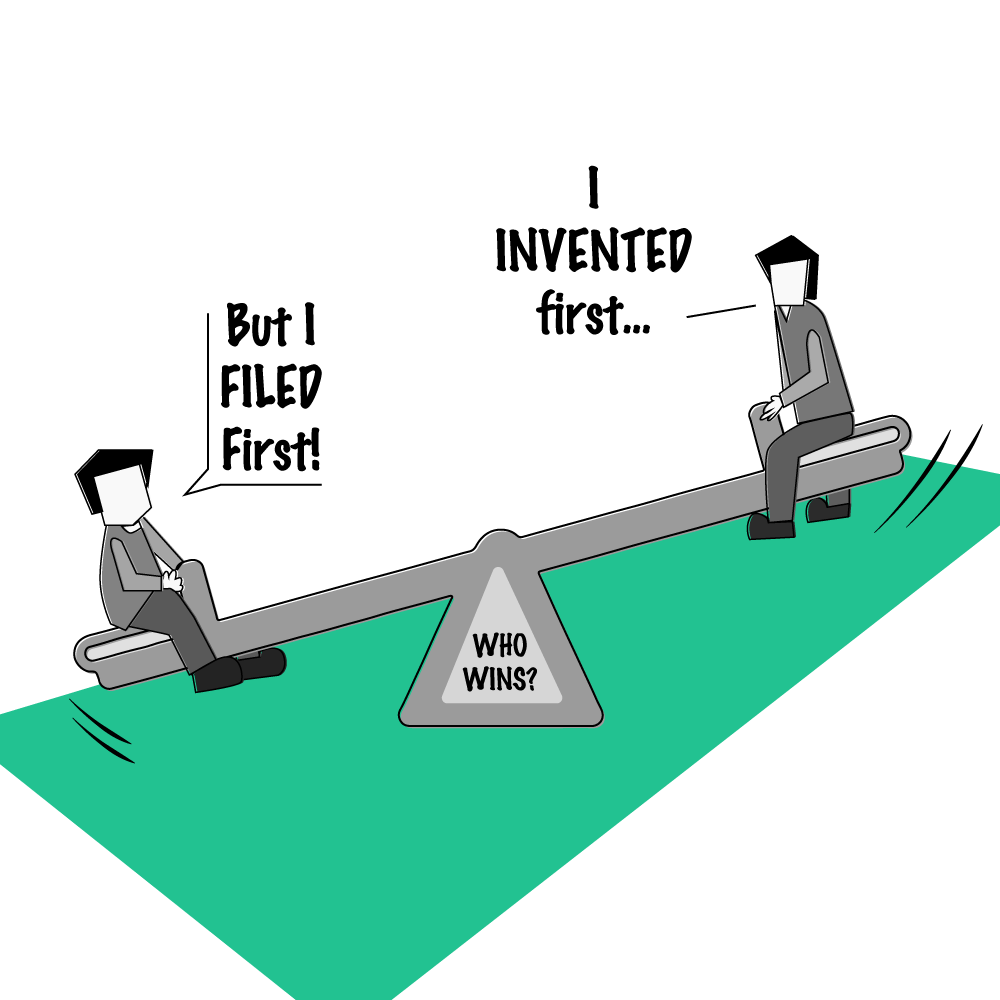How The First To File Rule Legally Affects Patent Applications

Introduction:
“With foresight as its guide, the early filer’s rights abide.”
In the early days of the patent regime, the First-to-Invent (FTI) rule prevailed, which granted patent protection to the first and true inventor who conceived the idea and reduced it to practice irrespective of the swift filing of the patent application. This rule was in consonance with the principles of common law and equity. But in the later stage, some countries adopted the First-to-File (FTF) rule by which the right to the grant of a patent vested with the first person to file a patent application for the protection of an invention, regardless of the date of the actual invention. This shift in patent law left Canada, Philippines, and USA to be the only countries to use FTI systems for decades until each of them adopted the new FTF patent system in 1989, 1998, and 2013 respectively.
Reasons Behind the Advent of the ‘FTF’ Rule:
The proponents of the FTF system asserted that the FTI system in patent law needs to be replaced and the FTF system is the best feasible way to grant a patent right, by reasoning that:
- The FTI system gave incentives to delay filing for patents
- The FTI system created substantial inefficiency due to the legal and procedural delays caused by competing inventors in a fight to manifest their priority in the invention
- The FTI system paved the way for a complex set of judicial decisions (like interference proceedings in the USA) about defining and identifying the scope and parameters to be the “first to invent”
- By virtue of the FTF system, it became easier to determine who is entitled to a patent, since ownership is solely determined by the date of filing and the expenses incurred in determining the same are trivial when compared to the FTI system
- The swifter the inventions are patented, the quicker they are brought to the market.
Contemporary Issues and Lacunas in the ‘FTF’ Rule:
In spite of the international harmonization in adopting the FTF patent system, the rule seemed to be against the very essence of patent protection which is to protect the rights of a true and first inventor. The proponents of the FTI system stoutly asserted the FTF system to be unfair and unjust for:
- The FTF system fails to protect the actual inventors but rather grants protection to whoever is savvy enough to file a patent application beforehand.
- The FTF system is inefficient and detrimental to creativity as it promotes a sense of “race to the patent office” which discourages inventors from investing considerable time to develop and enhance their invention to make it as useful as possible.
- The FTF system makes a victim of idea theft suffer invariably to get back his rights whilst also providing narrow opportunities for him to prove the same.
- The FTF system places the inventors with fewer resources and applicants who opt to file on their own without an attorney, in a very disadvantaged position.
- The FTF system favors corporate applicants and patent trolls as against individual inventors.
Legal Position in India
The legal stand of India in this regard is quite complicated yet envisages a great deal of fair, just, and conscientious application of the First-to-File system without failing to preserve the intention behind patent legislation i.e., to protect the creativity of a genuine inventor. It is no blunder to say that in India both the FTF and FTI rules coexist. India follows these two patent rules separately in two different scenarios.
- Parallel Invention
This is where India completely relies on the First-to-File rule. A parallel invention happens whenever there is no fraud on the part of the Applicant who applies for patent protection. In other words, when an Applicant has made an invention that is similar to another without having knowledge of that other invention i.e. genuine simultaneous invention. In such a case, the priority of the invention is not considered, but rather the priority of the application is taken into account as the other inventor kept the invention to himself, even if he actually came up with the invention first. This may be deemed as an extension of the First-to-Disclose rule since there is no use in an invention if it is not timely disclosed and subsequently contributes to the growth of society by way of its practical application.
- The Element of Fraud
It is obvious from the patent legislation in India (The Patent Act, 1970) that at any cost a ‘true and first inventor’ of an invention is to be protected against fraudulent representations and wrongful obtainment of the invention by another. Section 6 of the Act provides the list of persons who can apply for patents, in which, sub-section (a) states “by any person claiming to be the true and first inventor of the invention”. Therefore, an Applicant must be a genuine inventor of the invention and also the first one to apply for patent protection, this is where the FTI and FTF systems coexist. The legislation also promotes the scope for further interpretation by providing a remedy to prove this “true inventorship” by virtue of Section 25(1)(a) [pre-grant opposition], Section 25(2)(a) [post-grant opposition within one year] and Section 64(1)(b) [revocation of patents], whereby the opposing party has to prove that the Applicant or patentee has wrongfully obtained the invention or any part thereof from the Opponent, constituting a patent infringement by fraud. Therefore, these provisions clearly envisage that in order to obtain patent protection, firstly a person must be a ‘true inventor’ who made the invention out of his own efforts which promotes the FTI rule and prohibits the exploitation of the FTF rule. Secondly, a person must be the ‘first inventor’ which in turn is proved by a prior disclosure of the invention or by the filing of a patent application which ipso facto promotes the FTF system.
In the case of Sonya Kapur v. Controller General of Patent, Designs and Trademark and Ors, the Hon’ble Delhi High Court in a writ petition held that “the right to oppose an application for the grant of a patent is a statutorily conferred right and cannot be defeated on technical considerations”. This clearly proves the legislative mandate of India to protect the “true and first inventor” of an invention.
Legal Position in Other Countries
United Kingdom:
Under the patent provisions prevalent in U.K, reference can be drawn from the Statute of Monopolies in 1623 under Section 6 of this Act which introduced the term “true and first inventor.” This definition persisted through the Patents Act of 1883, which declared any patent granted to a party other than the “true and first inventor” as null and void. Notwithstanding this provision, the UK adhered to a first-to-file (FTF) system and it was adopted because the label “true and first inventor “ of any invention lacks its substance without accompanying disclosure. For considering any patent socially relevant the disclosure is most essential and that can happen only on filing at the first instance and possessing mere idea holds no good. This principle of first disclosure evolved into the modern-day FTF rule, guided by the principle that the individual who promptly presents their invention to the authorities and divulges it to the public deserves the privilege of reaping the invention’s rewards.
Consequently, the individual deemed the “true and first inventor” is not necessarily the initial creator, but rather the pioneer in filing, since filing is what effectively exposes the invention to the public. Consequently, from a legal standpoint, the first to file is synonymous with the first to invent with a few of the exceptions to the contrary.
United States:
The America Invents Act, which was endorsed by Barack Obama on September 16, 2011, marked a transition in the United States patent system. It shifted the patent right from a “first-to-invent” approach to a “first-inventor-to-file” system, applicable to patent applications submitted on or after March 16, 2013, while also eliminating interference proceedings. For an inventor, it is advisable to promptly file their application with the USPTO as soon as they determine their invention’s eligibility for a patent. The most effective means to establish their rights efficiently is by initiating a provisional patent application. There exists a one-year grace period between the submission of a PPA and the actual patent application; however, if the PPA expires prior to the submission of the official patent application, another individual can potentially patent a similar concept. The shift to a first-to-file patent system also brought about a change in the method of challenging a patent, often referred to as “prior art.” This encompasses printed publications detailing the invention, existing patents, sales, or public uses. If this prior art was accessible before the earliest filing date of the PPA, it could lead to the rejection of the patent application. This shift underscores the implementation of the First-to-Disclose principle, aiming to avoid being categorized as prior art.
Conclusion
On a concluding note, it can be observed that, the FTF system is followed internationally despite its drawbacks, while some countries have modified their laws to build a synergic relationship between the FTI and FTF systems of patent protection. It is of no predisposition to say that the person who first conceived an idea genuinely is the true inventor but if such a conception is not reduced constructively into practice, another inventor who subsequently conceives an idea and reduces it to practice and applies a patent can be granted patent protection since the former merely constitutes “secret prior art” which cannot be of use and value in the patent regime.

